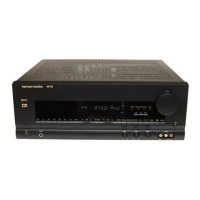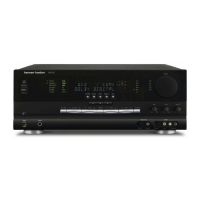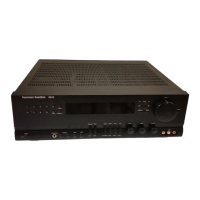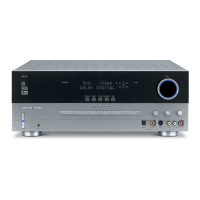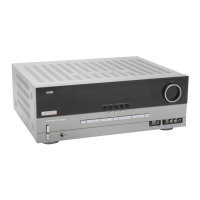OPERATION 35
Operation
a DVD is put into a Pause mode. The flashing
indicators remind you that the playback has
stopped due to the absence of a digital signal
and not through any fault of the AVR 5500. This
is normal, and the digital playback will resume
once the playback is started again.
Night Mode
A special feature of Dolby Digital is the Night
mode, which enables Dolby Digital input sources
to be played back with full digital intelligibilty
while reducing the maximum peak level and lift-
ing the low levels by
1/4
to 1/
3. This prevents
abruptly loud transitions from disturbing others
without reducing the impact of the digital source.
The Night mode is available only when the Dolby
Digital mode is selected.
The Night mode may be engaged when a Dolby
Digital DVD is playing by pressing the Night
Button
B
on the remote. Next, press the ⁄/¤
buttons
D
to select either the middle range or
full compression versions of the Night mode. To
turn the Night mode off, press the
⁄/¤ buttons
D
until the message in the lower third of the
video display and the Main Information
Display
Y
reads D-RANGE OFF.
The Night mode may also be selected to always
be on as soon as the Dolby Digital mode is acti-
vated at either level of compression using the
options in the Surround Select
menu. See page 25 for information on using the
menus to set this option.
IMPORTANT NOTES ON DIGITAL PLAYBACK:
• When the digital playback source is stopped, or
in a pause, fast forward or chapter search mode,
the digital audio data will momentarily stop, and
the channel position letters inside the
Speaker/Channel Indicators
Q
will flash.
This is normal and does not indicate a problem
with either the AVR 5500 or the source machine.
The AVR 5500 will return to digital playback as
soon as the data is available and when the
machine is in a standard play mode.
• Although the AVR 5500 will decode virtually all
DVD movies, CDs and HDTV sources, it is possible
that some future digital sources may not be com-
patible with the AVR 5500.
• Note that not all digitally encoded programs
and not all audio tracks on a DVD contain full
5.1-channel audio. Consult the program guide
that accompanies the DVD or laser disc to deter-
mine which type of audio has been recorded on
the disc. The AVR 5500 will automatically sense
the type of digital surround encoding used, indi-
cate it in the Bitstream Indicators
A
and
Channel Input Indicators
Q
and adjust to
accommodate it.
• When a Dolby Digital or DTS source is playing,
you normally may not be able to select some of
the analog surround modes such as Dolby Pro
Logic II, Dolby 3 Stereo, Hall, Theater, 5CH/7CH
Stereo or Logic 7, except with specific Dolby
Digital 2.0 recordings that can be played with
the Pro Logic II modes too (see page 34).
• When a digital source is playing, it is not possi-
ble to make an analog recording using the Tape
or Video 1 or Video 2 or
record out-
puts, if the source is connected to any digital
input of the AVR 5500 only. But the analog two
channel signal of that source, the ”Downmix” to
Stereo or Dolby Surround, can be recorded by
connecting its analog audio outputs to the
appropriate analog inputs (e.g. DVD) of the
AVR 5500, even if the digital input of the
AVR 5500 remains selected. Additionally, the dig-
ital signals will be passed through to the Digital
Audio Outputs
.
Tape Recording
In normal operation, the audio or video source
selected for listening through the AVR 5500 is
sent to the record outputs. This means that any
program you are watching or listening to may be
recorded simply by placing machines connected
to the outputs for Tape Outputs
or Video 1
or 2 Outputs
in the record mode.
When a digital audio recorder is connected to
any of the Digital Audio Outputs
, you are
able to record the digital signal using a CD-R,
MiniDisc or other digital recording system.
Note that all digital signals will be passed
through to both, coaxial and optical, digital out-
puts simultanously, no matter which kind of digi-
tal input was selected.
Front Panel In/Outputs
In addition to the rear panel digital outputs, the
AVR 5500 offers Harman Kardon’s exclusive con-
figurable front panel output jack feature. For easy
connection of portable devices, you may switch
the front panel Digital Coax 3 jack
Ó
or the
Video 4 jack
Ô
from an input to an output by
following these steps:
1. Press the OSD button
L
to view the
MASTER MENU (Figure 1).
2. Press the Set button
F
to enter the
IN/OUT SETUP menu (Figure 2).
3. Press the
¤
button
D
so that the on-screen
›
cursor is next to VIDEO 4 or COAXI-
AL3 depending on which input you wish to
change to an output. Either input, or both may
be changed at any time.
4. Press either of the
‹
/
›
buttons
E
/
so
that the word OUT is highlighted.
5. Press the OSD button
L
to exit the menus
and return to normal operation.
Note that once the setting is made, the appropri-
ate Input/Output Status Indicator ( will
turn red, indicating that the selected analog or
digital jacks are now an output, instead of in the
default setting as an input. Once changed to an
output, the setting will remain as long as the
AVR 5500 is turned on, unless the setting is
changed in the OSD menu system, as described
above. Note, however, that once the AVR 5500 is
turned off, the setting is cancelled. When the unit
is turned on again, the front panel jacks will
return to their normal default setting as an input.
If you wish to use the jacks as an output at a
future time, the setting must be changed again
using the OSD menu system, as described above.
NOTES:
• The digital outputs are active only when a digital
signal is present, and they do not convert an ana-
log input to a digital signal, or change the format
of the digital signal (e.g. Dolby Digital to PCM or
vice versa, but coaxial digital signals are converted
to optical signals and vice versa). In additon, the
digital recorder must be compatible with the out-
put signal. For example, the PCM digital output
from a CD player may be recorded on a CD-R or
MiniDisc, but Dolby Digital or DTS signals may not.
• To make an analog recording from any digital
source is not possible, if the source is connected
to a digital input of the AVR 5500 only. But the
analog two channel signal of that source can be
recorded (see ”Important Notes on Digital
Playback” above).
Output Level Adjustment
With Source Signals
Normal output level adjustment for the
AVR 5500 is established using the test tone, as
outlined on page 26. In some cases, however, it
may be desirable to adjust the output levels
using program material such as a test disc, or a
selection you are familiar with. Additionally, the
output level for the subwoofer and those for the
Stereo and VMAx modes can only be adjusted
using this procedure. Note that all adjustments
made with any input will be effective with all
inputs selected, just as it is the case with the
adjustment using the test tone.
To adjust the output levels using program materi-
al, first select the surround mode for which you
want to trim the speakers (see NOTE below), start
your program material source and set the refer-
ence volume for the front left and front right
channels using the Volume Control
î
.
Once the reference level has been set, press the
Channel Select button
C
Ù
and note that
FRONT L LEV will appear in the Main
Information Display
Y
. To change the level,
first press the Set button
F
@
, and then use

